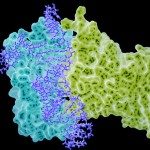Link to Pubmed [PMID] – 25139910
Mol. Cell Proteomics 2014 Nov;13(11):2812-23
The use of in vivo Förster resonance energy transfer (FRET) data to determine the molecular architecture of a protein complex in living cells is challenging due to data sparseness, sample heterogeneity, signal contributions from multiple donors and acceptors, unequal fluorophore brightness, photobleaching, flexibility of the linker connecting the fluorophore to the tagged protein, and spectral cross-talk. We addressed these challenges by using a Bayesian approach that produces the posterior probability of a model, given the input data. The posterior probability is defined as a function of the dependence of our FRET metric FRETR on a structure (forward model), a model of noise in the data, as well as prior information about the structure, relative populations of distinct states in the sample, forward model parameters, and data noise. The forward model was validated against kinetic Monte Carlo simulations and in vivo experimental data collected on nine systems of known structure. In addition, our Bayesian approach was validated by a benchmark of 16 protein complexes of known structure. Given the structures of each subunit of the complexes, models were computed from synthetic FRETR data with a distance root-mean-squared deviation error of 14 to 17 Å. The approach is implemented in the open-source Integrative Modeling Platform, allowing us to determine macromolecular structures through a combination of in vivo FRETR data and data from other sources, such as electron microscopy and chemical cross-linking.
